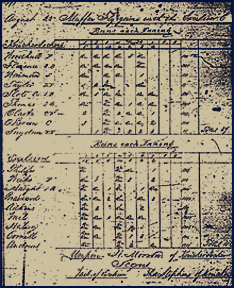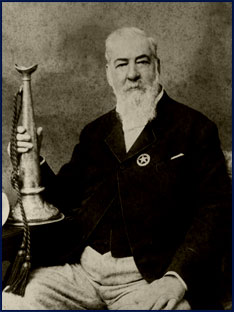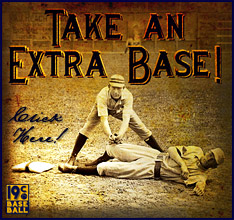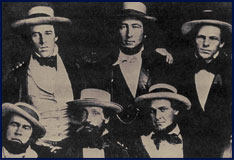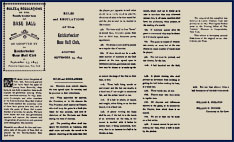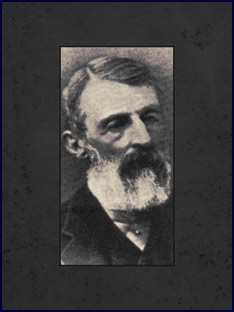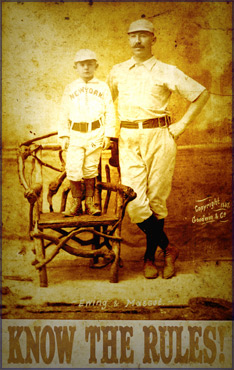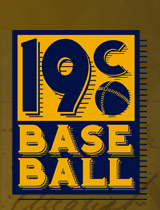Baseball in Canada
anada claims the first recorded account of a baseball game, which occurred in Beechville, Ontario on June 4, 1838, described in a detailed letter written by Dr. Adam E. Ford, but not published until 38 years later on May 5, 1886, in a magazine called Sporting Life. In this letter, the game was described as having five bases or "byes," base lines twenty-one yards in length and the distance from the pitcher to the home bye was fifteen yards. Innings determined the length of the game as opposed to playing to a specific number of runs. Fairly and unfairly pitched balls were described and techniques mentioned for the pitcher to make it difficult for the "knocker" to hit the ball. The differences between "fair and" "no-hit" balls were described and each side was given three outs per inning.
Baseball Makes News
The earliest known newspaper account of a Baseball game in the United States was published on September 11, 1845, in the New York Morning News, which announced a game that occurred the previous day. The first recorded Baseball game was played on October 6, 1845 at Elysian Fields, in Hoboken, New Jersey by fourteen members of the New York Knickerbockers Club. One team may have been captained by Alexander Cartwright and the other by club president Duncan Curry. Curry's team won 11–8 in three innings. Between October 6 and November 18, 1845, the Knickerbockers may have played as many as fourteen more intra-squad games.
Cartwright and the Knickerbockers
Alexander Joy Cartwright (1820–1892) is often referred to as "The Father of Baseball" for his role in organizing a group of ballplayers whom he exercised with since 1842 into one of Baseball's first known teams, the New York Knickerbockers. On September 23, 1845, by virtue of its constitution and by-laws, the Knickerbocker Base Ball Club was officially formed. Cartwright scribed twenty rules, which were published and became known as the "20 Original Rules of Baseball" or the "Knickerbocker Rules." The team's first elected officers were: Duncan Curry, President; William Wheaton, Vice President; and William Tucker, Secretary/Treasurer. Curry, Wheaton and Tucker comprised the Knickerbocker Committee on By-Laws and their names appeared on the signed by-laws document that contained the rules.
The new rules changed Baseball in a number of ways—further differentiating it from Town Ball—three strikes to a batter, three outs to an inning, tags and force-outs in lieu of hitting a runner with a thrown ball, and the addition of an umpire. The 1845 rules also established the idea of "fair" and "foul" territory. Previously, the batter could run the bases any time he hit the ball, as in cricket. The Knickerbocker version of the game became known as the "New York Game" distinguishing it from "Town Ball" and "The Massachusetts Game."
Early on the Knickerbockers moved from the Murray Hill section of Manhattan to Hoboken, New Jersey to play their games at Elysian Fields. What is often referred to as the first recorded game played under the Knickerbocker Rules (now believed to be yet another intra-squad game), took place on June 19, 1846, when the Knickerbockers lost to the New York Baseball Club (aka "the New York Nine") 23–1 in four innings. The winning team was comprised mainly of Knickerbocker players. Cartwright umpired the contest and enforced a six-cent fine, payable on the spot, for swearing.
A team called a “Picked Nine” or “The (blank) Nine,” most often referred to a team of players put together for that day or for a specific game. These players were not necessarily part of the same club.
Daniel "Doc" Adams
Daniel "Doc" Adams (1814–1899) was elected President of the Knickerbockers in 1846. Two years later he headed the Committee to Revise the Constitution and By-Laws with Cartwright serving under him. Cartwright left New York on March 1, 1849, for the California Gold Rush and eventually ended up in Hawaii.
Adams has been credited with "inventing" the 'short-fielder' or 'shortstop' position in 1849 or 1850. The position evolved because the baseballs used, handmade by Adams, were light and could not be thrown far. A non-base-tending player was needed to retrieve balls from the outfielders and return them to the pitcher.
Under Adams’ presidency (1846–1862), the Knickerbocker Club became the model upon which all early clubs were organized. So dominant was the Knickerbocker Club during the 1840's and 1850's, that they transformed Elysian Fields in Hoboken, New Jersey into the first great center of Baseball activity in the United States.
The First Base Ball Convention
Considered by some to be the true "Father of Baseball," "Doc" Adams was elected president of the first Base Ball Convention in 1857. He also headed the Committee on Rules and Regulations that year, which instituted the following rules: nine equal innings for a full game, five equal innings for a complete game, 30 yard distance between the four bases, the pitching distance should be 45 feet and he also stated that nine men should comprise a team.
With the rules better defined and with the success of the 1857 convention, the game became increasingly popular. Subsequent conventions attracted more teams. The Civil War caused membership to decrease but helped introduce the game to southern parts of the United States. The membership of the National Association of Base Ball Players increased to more than 300 members in 1867.
Doc Adams' Legacy
Adams was elected as Chairman of the Committee on Rules and Regulations during the March 1858 Base Ball Convention in which the National Association of Base Ball Players was formed. He resigned in 1862 and two years later the bound rule which he fought since 1857 was abolished. He also resigned from the Knickerbockers in 1862 and played in his last base ball game in September 1875 in an "old-timers" match arranged by formed Knickerbocker James Whyte Davis. Adams died on January 3, 1899.
Under Adams' presidency (1846-1862), the Knickerbocker Club became the model upon which all early clubs were organized. So dominant was the Knickerbocker Club during the 1840's and 1850's, that they transformed Elysian Fields in Hoboken, New Jersey into the first great center of Baseball activity in the United States.
